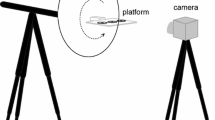Abstract
The landing response of stationary flying houseflies Musca domestica has been recorded on video tape. The leg movements were quantitatively evaluated. It could be demonstrated that:
-
1)
only the first two pairs of legs are involved in the reaction (Fig. 1). Prothoracic tarsi are lifted beyond the head, mesothoracic tarsi are lowered and moved sidewards (Fig. 2a and b).
-
2)
the movement of the tarsal tips is mainly due to an opening of one single joint per leg, i.e. the femurtibia joint of the prothoracic leg (Fig. 2c), and the coxa-femur joint of the mesothoracic leg.
-
3)
the landing reaction is a fixed action pattern which does not seem to require further sensory input once it is released (Fig. 4d).
-
4)
the landing responses to a light-off stimulus and to expanding patterns with different angular velocities are indistinguishable (compare Fig. 3a-c with Fig. 2a-c). The only parameter that is obviously dependent on the stimulus conditions, is the latency of the reaction (Fig. 4a-c).
Similar content being viewed by others
References
Borst A, Bahde S (1986) What kind of movement detector is triggering the landing response of the housefly? Biol Cybern (submitted)
Coggshall JC (1972) The landing response and visual processing in the milkweed bug, Oncopeltus fasciatus. J Exp Biol 57:401–417
Eckert H (1980) Orientation sensitivity of the visual movement detection system activating the landing response of the blowflies, Calliphora and Phaenicia: a behavioural investigation. Biol Cybern 37:235–247
Fischbach KF (1981) Habituation and sensitization of the landing response of Drosophila melanogaster. Naturwissenschaften 68:332
Goodman LJ (1960) The landing response of insects. I. The landing response of the fly, Lucilla sericata, and other Calliphorinae. J Exp Biol 37:854–878
Götz KG, Hengstenberg B, Biesinger R (1979) Optomotor control of wing beat and body posture in Drosophila. Biol Cybern 35:101–112
Perez de Talens AF, Taddei-Ferretti C (1970) Landing reaction of Musca domestica: dependence of dimensions and position of the stimulus. J Exp Biol 52:233–256
Tinbergen J, Abeln RG (1983) Spectral sensitivity of the landing blowfly. J Comp Physiol 150:319–328
Wagner H (1982) Flow-field variables trigger landing in flies. Nature 297:147–148
Wehrhahn C, Hausen K, Zanker J (1981) Is the landing response of the housefly driven by motion of a flowfield? Biol Cybern 41:91–99
Author information
Authors and Affiliations
Rights and permissions
About this article
Cite this article
Borst, A. Time course of the Houseflies' landing response. Biol. Cybern. 54, 379–383 (1986). https://doi.org/10.1007/BF00355543
Received:
Issue Date:
DOI: https://doi.org/10.1007/BF00355543



